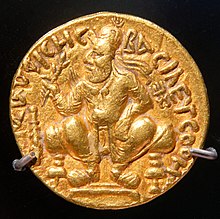
Back ভীম কদফিসেস Bengali/Bangla Vima Kadphises Czech Vima Kadphises German Βήμα Καδφίσης Greek Vima Kadphises Spanish ویما کادفیسس FA Vima Kadphisès French विम कडफिसेस HI Vima Kadfises ID Vima Kadphises Italian
| Vima Kadphises | |
|---|---|
| Kushan emperor | |
 Double stater of Vima Kadphises. Obverse: diademed and crowned figure of Vima Kadphises seated facing on stool with ornate legs, head left, feet on footstool, holding laurel branch in raised right hand. Corrupted Greek language legend: ΒΑΣΙΛΕΥΣ ΟΟΗΜΟ ΚΑΔΦΙϹΗϹ ("Basileus Ooimo Kadphisis"): "King Vima Kadphises". Afghanistan. Guimet Museum, MG24356 | |
| Reign | 113–127 CE |
| Predecessor | Vima Takto |
| Successor | Kanishka |
| Dynasty | Kushan |
| Religion | Hinduism[1] |
Statue of Vima Kadphises
Vima Kadphises (or possibly Vima Takto)[2] on throne. The name of the ruler is mentioned in an epigraphic inscription at the feet of the statue. The inscription reads:
Maharaja rajatiraja devaputra
Mathura Museum.
Maharaja rajatiraja devaputra
Kushanaputra (Shahi Vamataksha) masya
Vakanapatina Huma (devakulu) karita
Mathura Museum.
Vima Kadphises (Greek: Οοημο Καδφιϲηϲ Ooēmo Kadphisēs (epigraphic); Kharosthi: 𐨬𐨁𐨨 𐨐𐨫𐨿𐨤𐨁𐨭 Vi-ma Ka-lpi-śa, Vima Kalpiśa) was a Kushan emperor from approximately 113 to 127 CE. According to the Rabatak inscription, he was the son of Vima Takto and the father of Kanishka.
- ^ McLaughlin, Raoul (11 November 2016). The Roman Empire and the Silk Routes. Pen and Sword. ISBN 978-1-4738-8981-1.
- ^ Revire, Nicolas (January 2017). "Kinsman of the Sun: An Early Buddha Image in the Asian Art Museum, Berlin, and Solar Symbolism". Indo-Asiatische Zeitschrift, Vol. 20-21, Pp. 3-14: 9.
- ^ Banerjee, Gauranga Nath (1920). Hellenism in ancient India. Calcutta : Published by the Author ; New York : Oxford University Press. p. 92.

